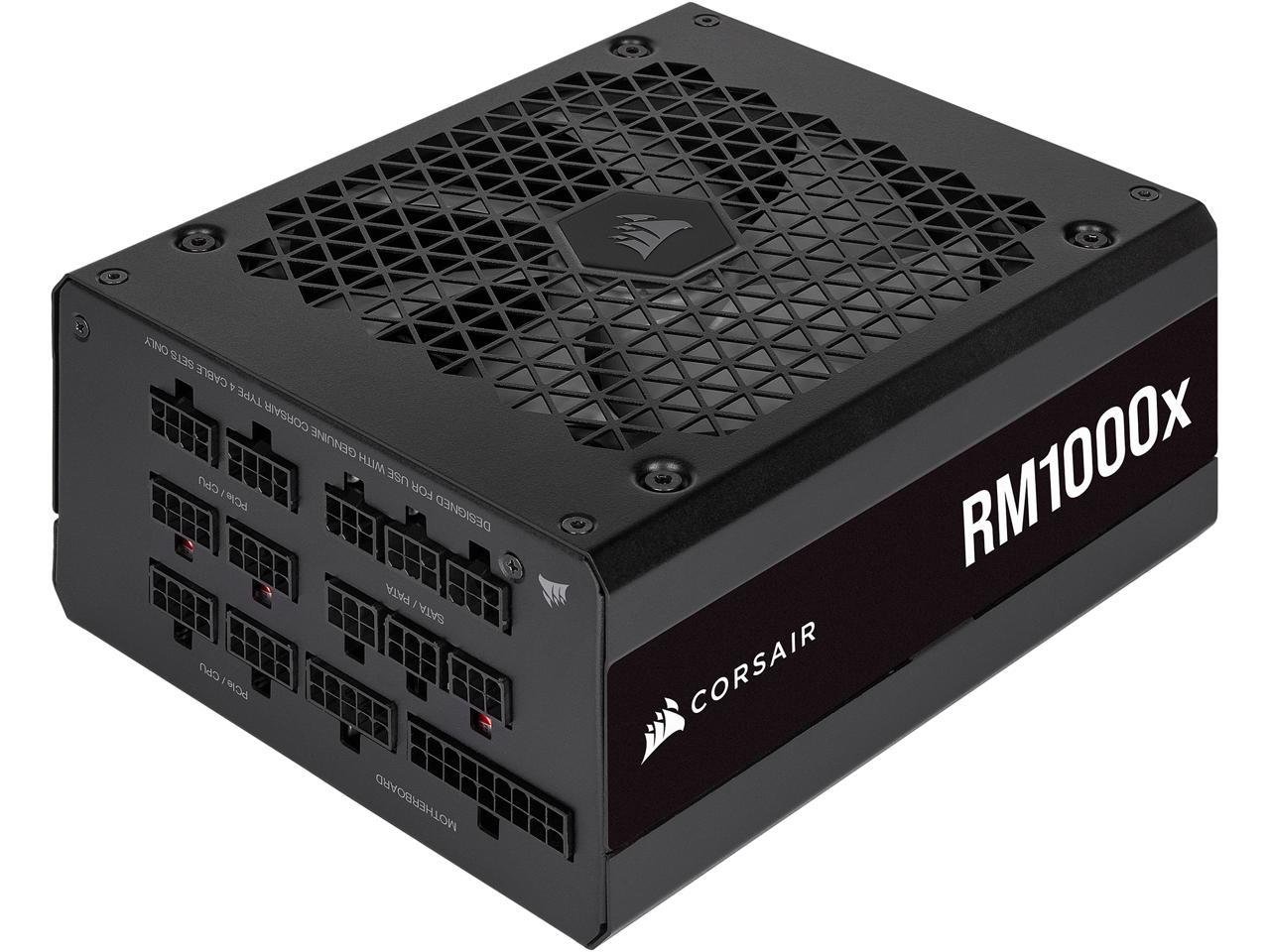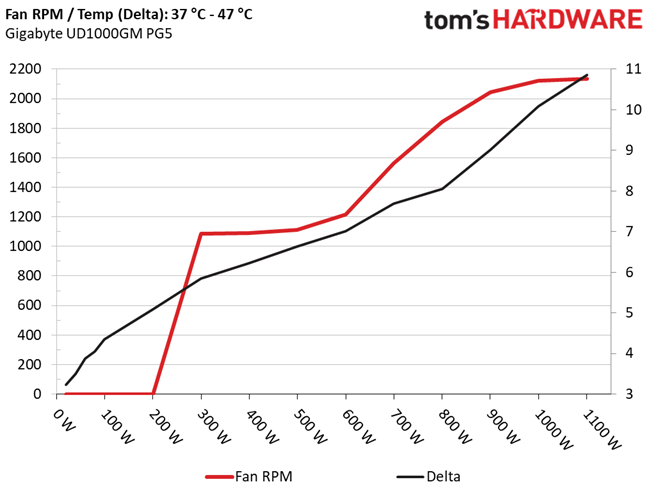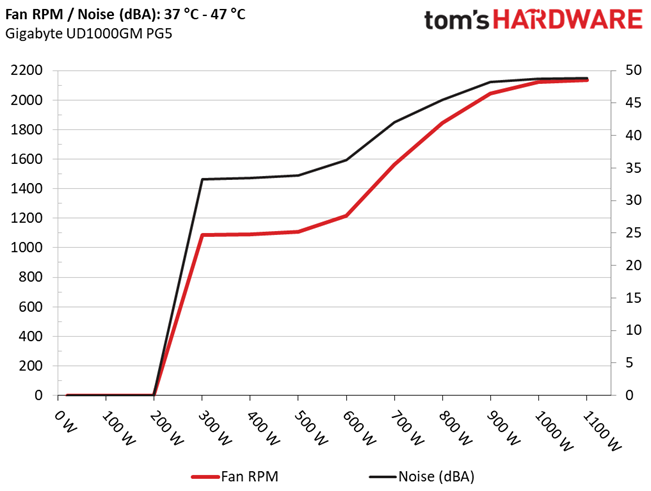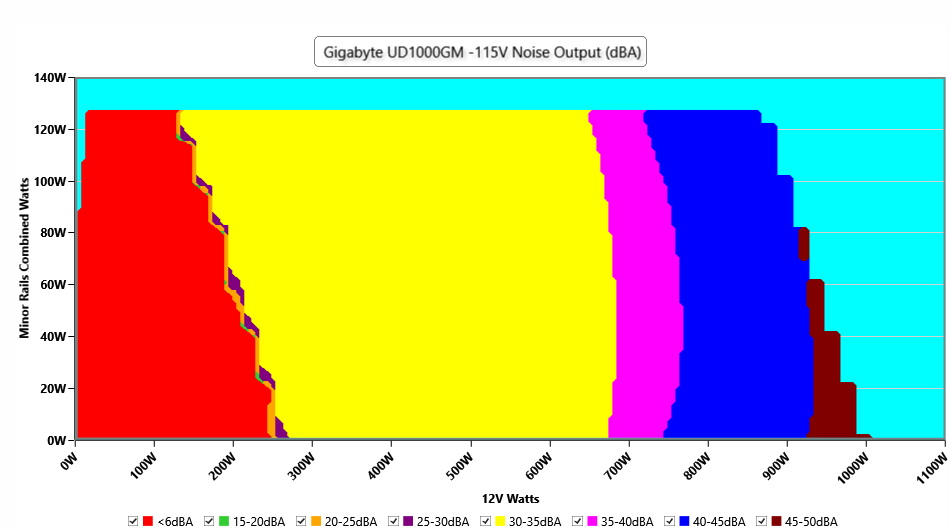Why you can trust Tom's Hardware
To learn more about our PSU tests and methodology, please check out How We Test Power Supply Units.
Primary Rails And 5VSB Load Regulation
The following charts show the main rails' voltage values recorded between a range of 40W up to the PSU's maximum specified load, along with the deviation (in percent). Tight regulation is an important consideration every time we review a power supply because it facilitates constant voltage levels despite varying loads. Tight load regulation also, among other factors, improves the system’s stability, especially under overclocked conditions and, at the same time, it applies less stress to the DC-DC converters that many system components utilize.


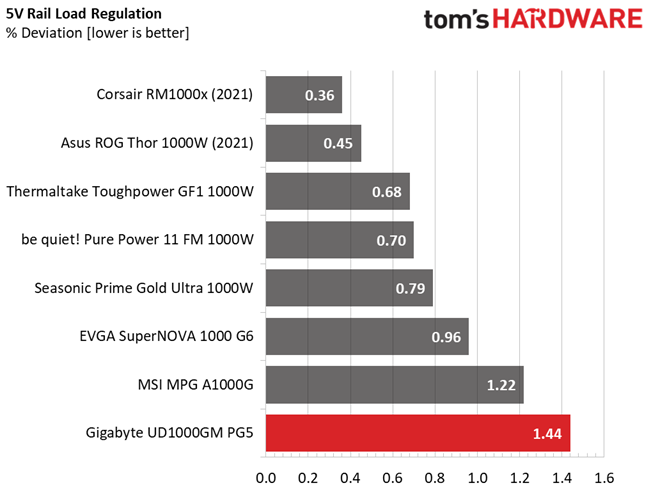
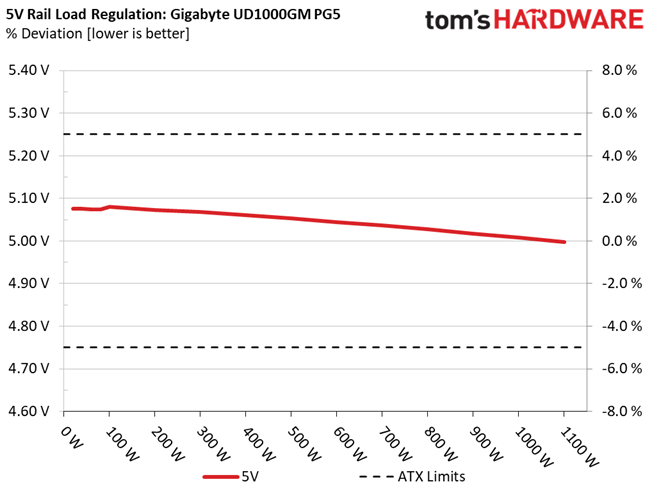
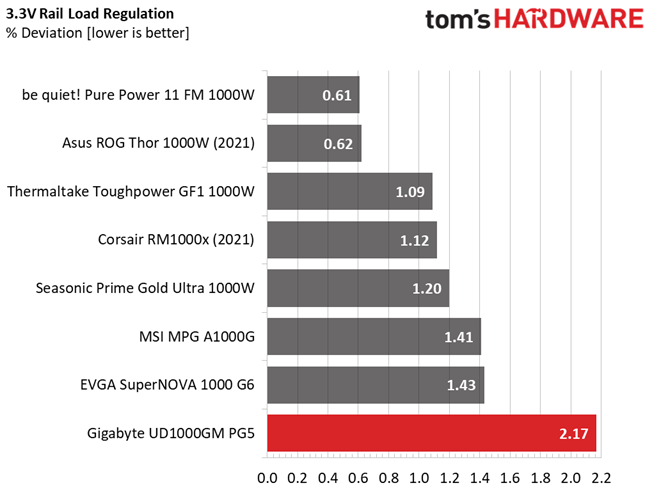
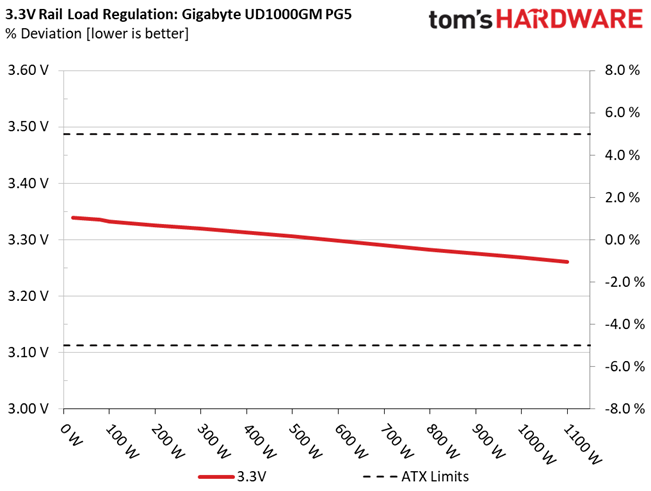

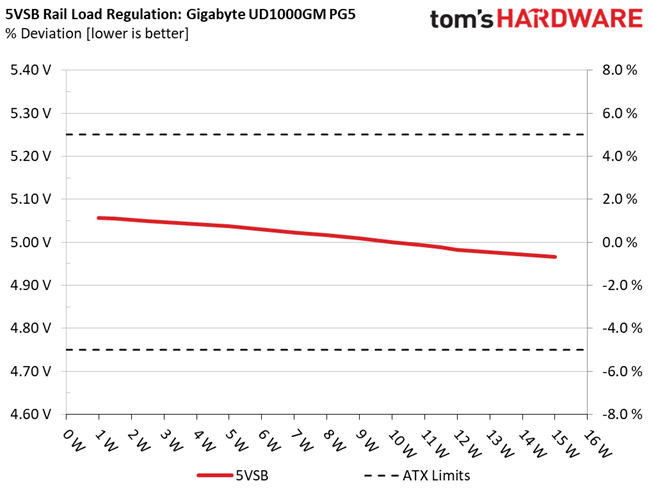
Load regulation is tight at 12V and 5VSB, and mediocre on the minor rails.
Hold-Up Time
Put simply; hold-up time is the amount of time that the system can continue to run without shutting down or rebooting during a power interruption.
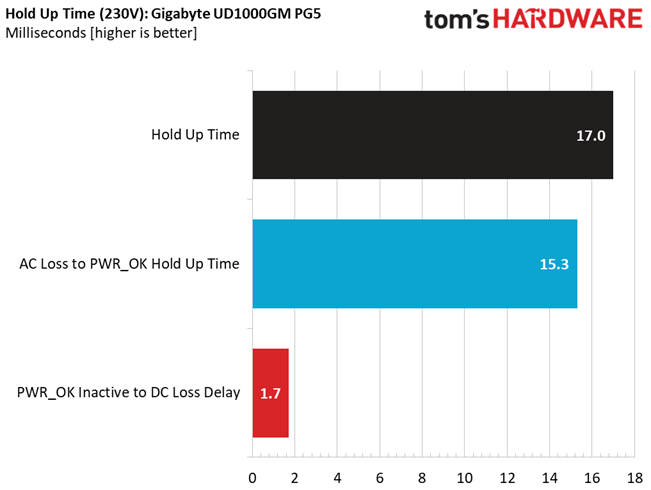
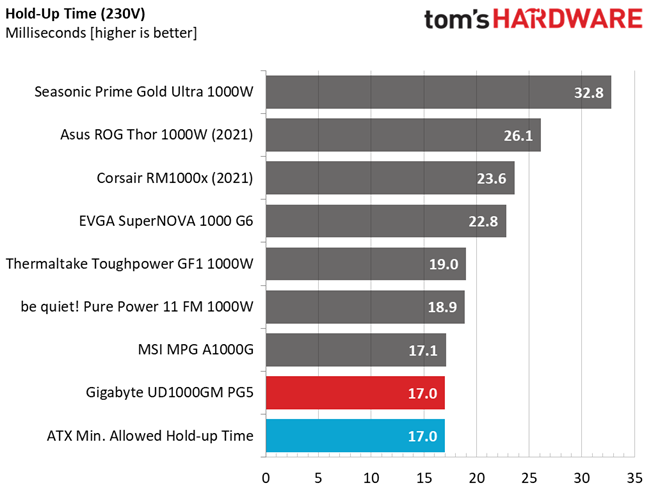

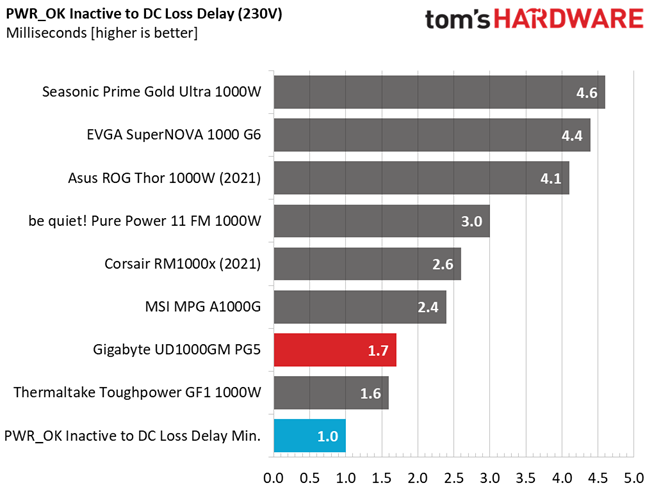
The hold-up time is at 17ms, aligning with the ATX spec's requirements. On the other hand, the power ok signal does not exceed 16ms. It is accurate, at least.
Inrush Current
Inrush current, or switch-on surge, refers to the maximum, instantaneous input current drawn by an electrical device when it is first turned on. A large enough inrush current can cause circuit breakers and fuses to trip. It can also damage switches, relays, and bridge rectifiers. As a result, the lower the inrush current of a PSU right as it is turned on, the better.

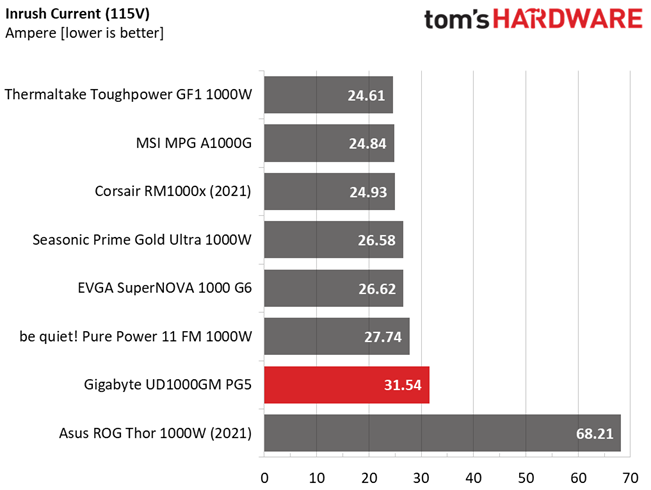
Inrush current is not so high with 115V, but this not the case with 230V.
Get Tom's Hardware's best news and in-depth reviews, straight to your inbox.
Leakage Current
In layman's terms, leakage current is the unwanted transfer of energy from one circuit to another. In power supplies, it is the current flowing from the primary side to the ground or the chassis, which in the majority of cases is connected to the ground. For measuring leakage current, we use a GW Instek GPT-9904 electrical safety tester instrument.
The leakage current test is conducted at 110% of the DUT's rated voltage input (so for a 230-240V device, we should conduct the test with 253-264V input). The maximum acceptable limit of a leakage current is 3.5 mA and it is defined by the IEC-60950-1 regulation, ensuring that the current is low and will not harm any person coming in contact with the power supply's chassis.
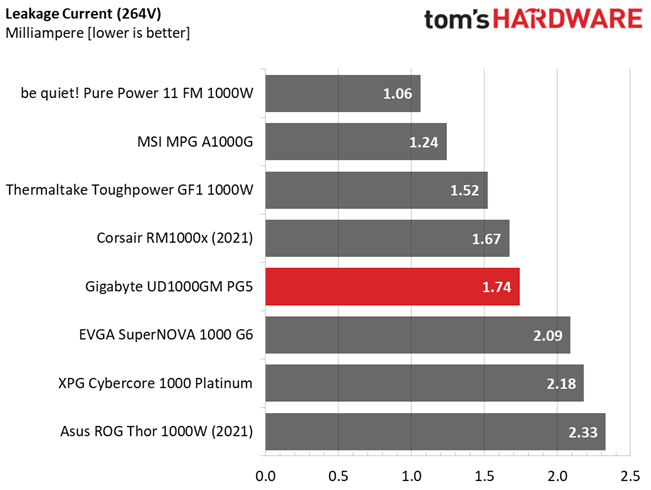
Leakage current is low.
10-110% Load Tests
These tests reveal the PSU's load regulation and efficiency levels under high ambient temperatures. They also show how the fan speed profile behaves under increased operating temperatures.
| Test | 12V | 5V | 3.3V | 5VSB | DC/AC (Watts) | Efficiency | Fan Speed (RPM) | PSU Noise (dB[A]) | Temps (In/Out) | PF/AC Volts |
| 10% | 6.516A | 1.969A | 1.98A | 0.993A | 100.01 | 87.382% | 0 | <6.0 | 44.87°C | 0.963 |
| Row 2 - Cell 0 | 12.032V | 5.08V | 3.332V | 5.038V | 114.441 | Row 2 - Cell 6 | Row 2 - Cell 7 | Row 2 - Cell 8 | 40.52°C | 115.13V |
| 20% | 14.046A | 2.958A | 2.978A | 1.193A | 199.963 | 90.554% | 0 | <6.0 | 46.17°C | 0.978 |
| Row 4 - Cell 0 | 12.037V | 5.073V | 3.325V | 5.03V | 220.814 | Row 4 - Cell 6 | Row 4 - Cell 7 | Row 4 - Cell 8 | 41.08°C | 115.1V |
| 30% | 21.954A | 3.454A | 3.479A | 1.394A | 300.017 | 91.076% | 1085 | 33.3 | 41.79°C | 0.984 |
| Row 6 - Cell 0 | 12.023V | 5.068V | 3.32V | 5.023V | 329.421 | Row 6 - Cell 6 | Row 6 - Cell 7 | Row 6 - Cell 8 | 47.64°C | 115.08V |
| 40% | 29.834A | 3.953A | 3.984A | 1.595A | 399.742 | 91.101% | 1091 | 33.5 | 42.15°C | 0.986 |
| Row 8 - Cell 0 | 12.018V | 5.06V | 3.313V | 5.016V | 438.787 | Row 8 - Cell 6 | Row 8 - Cell 7 | Row 8 - Cell 8 | 48.38°C | 115.05V |
| 50% | 37.368A | 4.949A | 4.992A | 1.797A | 499.476 | 90.772% | 1110 | 33.8 | 43.21°C | 0.988 |
| Row 10 - Cell 0 | 12.015V | 5.053V | 3.306V | 5.009V | 550.246 | Row 10 - Cell 6 | Row 10 - Cell 7 | Row 10 - Cell 8 | 49.85°C | 115.01V |
| 60% | 44.972A | 5.949A | 6.004A | 2A | 600.014 | 90.247% | 1216 | 36.2 | 43.58°C | 0.989 |
| Row 12 - Cell 0 | 12.012V | 5.044V | 3.298V | 5.001V | 664.857 | Row 12 - Cell 6 | Row 12 - Cell 7 | Row 12 - Cell 8 | 50.59°C | 114.99V |
| 70% | 52.516A | 6.953A | 7.022A | 2.203A | 699.768 | 89.538% | 1561 | 42.0 | 43.73°C | 0.99 |
| Row 14 - Cell 0 | 12.009V | 5.036V | 3.29V | 4.993V | 781.531 | Row 14 - Cell 6 | Row 14 - Cell 7 | Row 14 - Cell 8 | 51.42°C | 114.96V |
| 80% | 60.136A | 7.96A | 8.042A | 2.306A | 799.809 | 88.791% | 1843 | 45.5 | 44.62°C | 0.992 |
| Row 16 - Cell 0 | 12.004V | 5.027V | 3.282V | 4.988V | 900.772 | Row 16 - Cell 6 | Row 16 - Cell 7 | Row 16 - Cell 8 | 52.67°C | 114.93V |
| 90% | 68.091A | 8.473A | 8.55A | 2.409A | 899.634 | 88.036% | 2044 | 48.2 | 44.98°C | 0.993 |
| Row 18 - Cell 0 | 12.001V | 5.017V | 3.275V | 4.983V | 1021.912 | Row 18 - Cell 6 | Row 18 - Cell 7 | Row 18 - Cell 8 | 53.99°C | 114.9V |
| 100% | 75.856A | 8.987A | 9.087A | 3.021A | 999.558 | 87.325% | 2120 | 48.7 | 45.06°C | 0.994 |
| Row 20 - Cell 0 | 11.995V | 5.008V | 3.268V | 4.966V | 1144.619 | Row 20 - Cell 6 | Row 20 - Cell 7 | Row 20 - Cell 8 | 55.15°C | 114.87V |
| 110% | 83.543A | 10.003A | 10.212A | 3.023A | 1100.101 | 86.507% | 2136 | 48.8 | 47.2°C | 0.994 |
| Row 22 - Cell 0 | 11.992V | 4.998V | 3.261V | 4.963V | 1271.689 | Row 22 - Cell 6 | Row 22 - Cell 7 | Row 22 - Cell 8 | 58.05°C | 114.84V |
| CL1 | 0.116A | 14.813A | 14.96A | 0A | 126.296 | 84.333% | 0 | <6.0 | 49.53°C | 0.969 |
| Row 24 - Cell 0 | 12.042V | 5.083V | 3.315V | 5.05V | 149.768 | Row 24 - Cell 6 | Row 24 - Cell 7 | Row 24 - Cell 8 | 43.61°C | 115.12V |
| CL2 | 0.116A | 24.393A | 0A | 0A | 126.392 | 83.338% | 0 | <6.0 | 50.84°C | 0.969 |
| Row 26 - Cell 0 | 12.048V | 5.124V | 3.31V | 5.062V | 151.662 | Row 26 - Cell 6 | Row 26 - Cell 7 | Row 26 - Cell 8 | 44.01°C | 115.11V |
| CL3 | 0.116A | 0A | 24.823A | 0A | 83.889 | 78.641% | 0 | <6.0 | 52.78°C | 0.962 |
| Row 28 - Cell 0 | 12.040V | 5.04V | 3.323V | 5.043V | 106.673 | Row 28 - Cell 6 | Row 28 - Cell 7 | Row 28 - Cell 8 | 44.78°C | 115.13V |
| CL4 | 83.347A | 0.001A | 0A | 0.002A | 1000.083 | 87.859% | 2126 | 48.7 | 45.81°C | 0.994 |
| Row 30 - Cell 0 | 11.998V | 4.985V | 3.275V | 5.039V | 1138.278 | Row 30 - Cell 6 | Row 30 - Cell 7 | Row 30 - Cell 8 | 55.83°C | 114.87V |
The PSU doesn't have a problem under harsh conditions, but don't expect it to be quiet. The passive operation lasted till 20% load in our tests, with the fan starting right away at almost 1100 RPM, which is too high. MEIC wants to ensure that the not-so-high quality caps on the secondary side will be ok under all conditions and outlive the warranty.
20-80W Load Tests
In the following tests, we measure the PSU's efficiency at loads significantly lower than 10% of its maximum capacity (the lowest load the 80 PLUS standard measures). This is important for representing when a PC is idle with power-saving features turned on.
| Test | 12V | 5V | 3.3V | 5VSB | DC/AC (Watts) | Efficiency | Fan Speed (RPM) | PSU Noise (dB[A]) | Temps (In/Out) | PF/AC Volts |
| 20W | 1.234A | 0.493A | 0.494A | 0.198A | 20.003 | 71.113% | 0 | <6.0 | 40.04°C | 0.864 |
| Row 2 - Cell 0 | 12.038V | 5.076V | 3.339V | 5.057V | 28.131 | Row 2 - Cell 6 | Row 2 - Cell 7 | Row 2 - Cell 8 | 36.81°C | 115.15V |
| 40W | 2.717A | 0.69A | 0.692A | 0.297A | 40.001 | 81.021% | 0 | <6.0 | 40.83°C | 0.921 |
| Row 4 - Cell 0 | 12.032V | 5.075V | 3.338V | 5.055V | 49.375 | Row 4 - Cell 6 | Row 4 - Cell 7 | Row 4 - Cell 8 | 37.34°C | 115.15V |
| 60W | 4.200A | 0.887A | 0.89A | 0.396A | 59.999 | 85.095% | 0 | <6.0 | 42.28°C | 0.944 |
| Row 6 - Cell 0 | 12.031V | 5.074V | 3.337V | 5.052V | 70.504 | Row 6 - Cell 6 | Row 6 - Cell 7 | Row 6 - Cell 8 | 38.4°C | 115.13V |
| 80W | 5.680A | 1.084A | 1.088A | 0.495A | 79.958 | 87.303% | 0 | <6.0 | 43.59°C | 0.951 |
| Row 8 - Cell 0 | 12.030V | 5.074V | 3.335V | 5.049V | 91.588 | Row 8 - Cell 6 | Row 8 - Cell 7 | Row 8 - Cell 8 | 39.54°C | 115.13V |
The fan doesn't spin at light loads, even at increased temperatures, so the PSU is silent. The efficiency levels are satisfactory, too.
2% or 10W Load Test
From July 2020, the ATX spec requires 70% and higher efficiency with 115V input. The applied load is only 10W for PSUs with 500W and lower capacities, while for stronger units, we dial 2% of their max-rated capacity.
| 12V | 5V | 3.3V | 5VSB | DC/AC (Watts) | Efficiency | Fan Speed (RPM) | PSU Noise (dB[A]) | Temps (In/Out) | PF/AC Volts |
| 1.464A | 0.264A | 0.264A | 0.053A | 20.099 | 71.259% | 0 | <6.0 | 29.52°C | 0.865 |
| Row 2 - Cell 0 | 12.025V | 5.078V | 3.341V | 5.06V | 28.206 | Row 2 - Cell 6 | Row 2 - Cell 7 | 27.36°C | 115.14V |
With a 2% load, efficiency is above 70%, which is what the ATX spec recommends.
Efficiency & Power Factor
Next, we plotted a chart showing the PSU's efficiency at low loads and loads from 10 to 110% of its maximum rated capacity. The higher a PSU’s efficiency, the less energy goes wasted, leading to a reduced carbon footprint and lower electricity bills. The same goes for Power Factor.
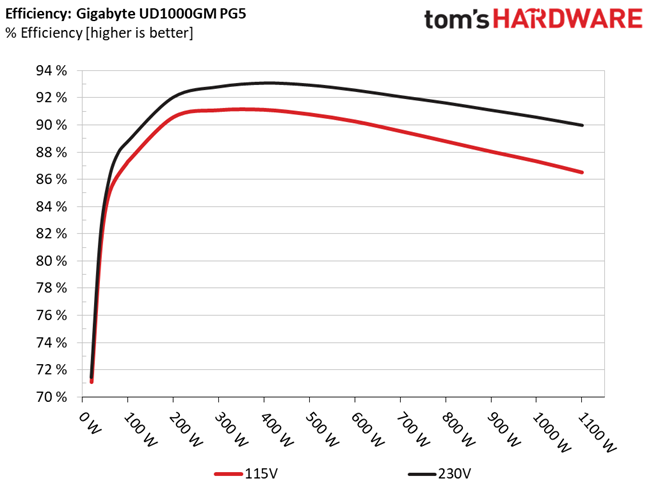
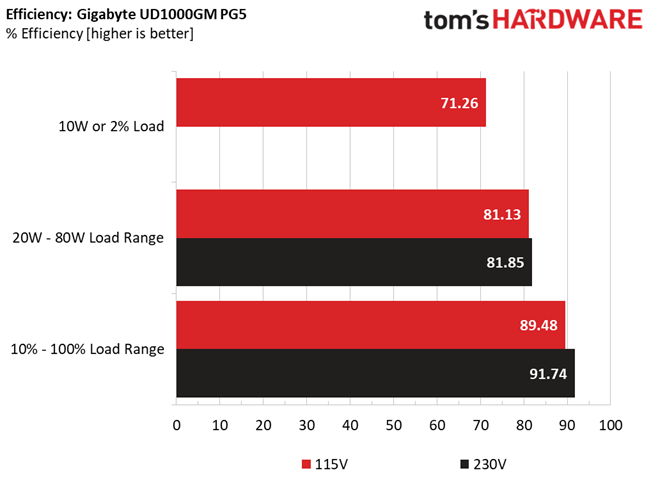


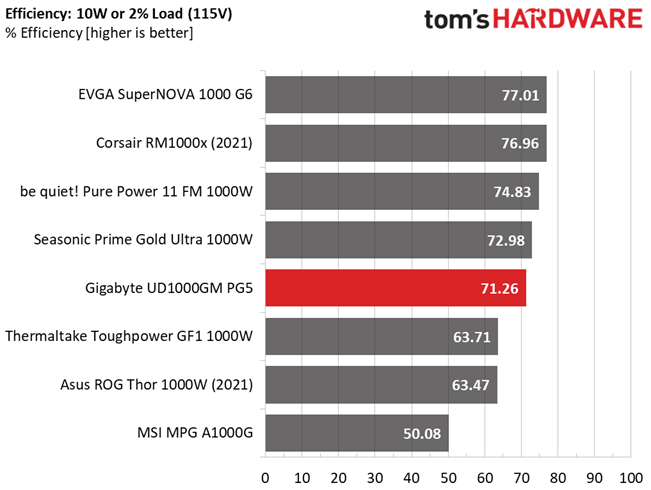
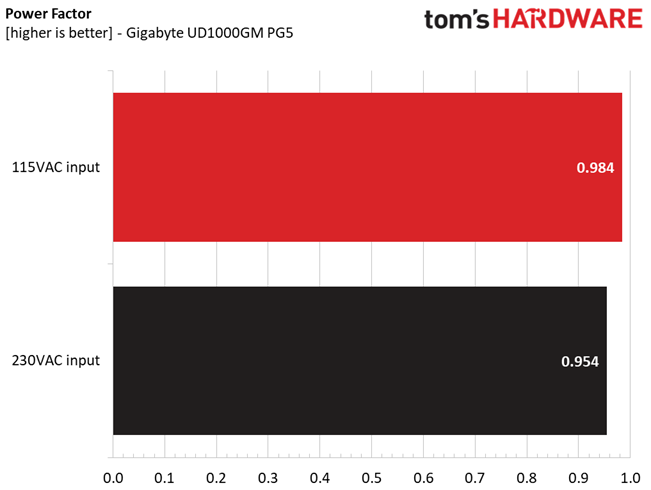
Even for the Gold standards, this platform is highly efficient in all load regions (high, low, and super-light). The APFC converter has decent performance.
5VSB Efficiency
| Test # | 5VSB | DC/AC (Watts) | Efficiency | PF/AC Volts |
| 1 | 0.1A | 0.506W | 74.323% | 0.078 |
| Row 2 - Cell 0 | 5.059V | 0.681W | Row 2 - Cell 3 | 115.16V |
| 2 | 0.25A | 1.265W | 78.783% | 0.167 |
| Row 4 - Cell 0 | 5.056V | 1.605W | Row 4 - Cell 3 | 115.15V |
| 3 | 0.55A | 2.778W | 80.895% | 0.284 |
| Row 6 - Cell 0 | 5.05V | 3.434W | Row 6 - Cell 3 | 115.15V |
| 4 | 1A | 5.042W | 81.319% | 0.366 |
| Row 8 - Cell 0 | 5.04V | 6.199W | Row 8 - Cell 3 | 115.15V |
| 5 | 1.5A | 7.547W | 81.132% | 0.412 |
| Row 10 - Cell 0 | 5.03V | 9.302W | Row 10 - Cell 3 | 115.16V |
| 6 | 3A | 15W | 79.311% | 0.47 |
| Row 12 - Cell 0 | 5V | 18.913W | Row 12 - Cell 3 | 115.15V |

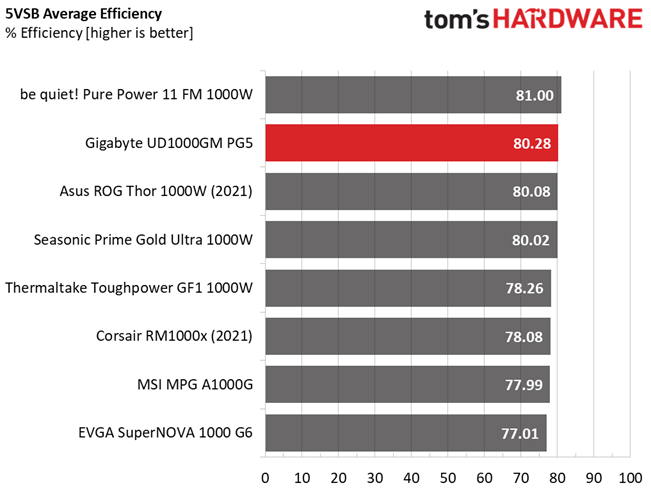
The 5VSB rail is highly efficient.
Power Consumption In Idle And Standby
| Mode | 12V | 5V | 3.3V | 5VSB | Watts | PF/AC Volts |
| Idle | 12.031V | 5.08V | 3.345V | 5.061V | 4.142 | 0.369 |
| Row 2 - Cell 0 | Row 2 - Cell 1 | Row 2 - Cell 2 | Row 2 - Cell 3 | Row 2 - Cell 4 | Row 2 - Cell 5 | 115.15V |
| Standby | Row 3 - Cell 1 | Row 3 - Cell 2 | Row 3 - Cell 3 | Row 3 - Cell 4 | 0.119 | 0.004 |
| Row 4 - Cell 0 | Row 4 - Cell 1 | Row 4 - Cell 2 | Row 4 - Cell 3 | Row 4 - Cell 4 | Row 4 - Cell 5 | 115.15V |
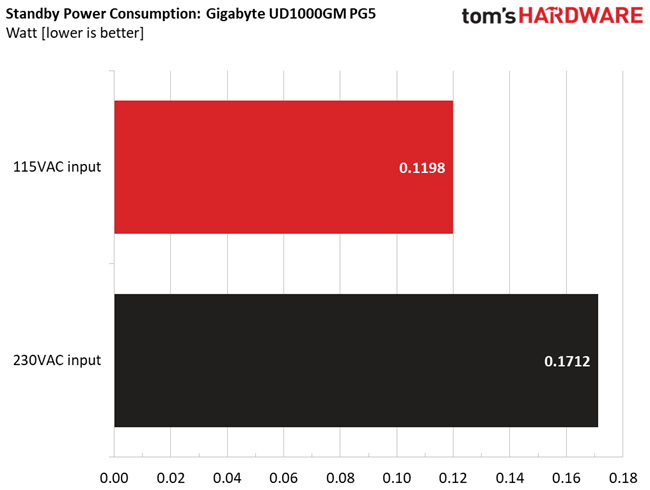
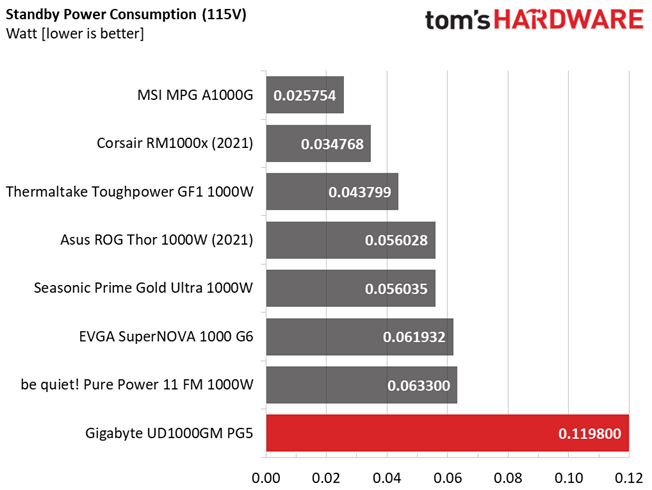
Vampire power is increased. Ideally, it should be below 0.1W.
Fan RPM, Delta Temperature, And Output Noise
All results are obtained between an ambient temperature of 37 to 47 degrees Celsius (98.6 to 116.6 degrees Fahrenheit).
The fan speed profile is aggressive. The compact dimensions of the PSU, the 120mm fans, and the low-grade caps on the secondary side don't leave room for lower fan speeds at high operating temperatures.
The following results were obtained at 30 to 32 degrees Celsius (86 to 89.6 degrees Fahrenheit) ambient temperature.
At average operating temperatures close to 30 degrees Celsius, the PSU is silent with up to 250W loads. The problem is that right after that, the PSU's noise exceeds 30 dBA. With around 680W, the fan's noise enters the 35-40 dBA range. With 750W, it goes above 40 dBA, and it passes the 45 dBA mark with around 930W loads. All in all, this is a noisy PSU.
MORE: Best Power Supplies
MORE: How We Test Power Supplies
MORE: All Power Supply Content
Current page: Load Regulation, Hold-Up Time, Inrush & Leakage Current, Efficiency and Noise
Prev Page Specifications and Part Analysis Next Page Protection Features, DC Power Sequencing, Cross-Load Tests and Infrared Images
Aris Mpitziopoulos is a contributing editor at Tom's Hardware, covering PSUs.
-
Udyr So this is a 4 star product with 1, 2, 3, 4... 12 cons?Reply
The cons are somewhat consistent with the review on TPU, but over there it was not a recommended product.
Maybe there's something more my ignorant self is not seeing here. -
DRagor ReplyUdyr said:So this is a 4 star product with 1, 2, 3, 4... 12 cons?The Gigabyte UD1000GM PG5 is the first PSU available with a 12+4 pin PCIe connector, so practically, it doesn't have any competitors yet.
How it was? In the land of blind one eyed is a king? -
WrongRookie No thanks. I'd rather wait for Seasonic do one than get another one that could end up explodingReply -
Udyr Reply
I understand the reference, but in this case, a unit with these many downsides doesn't justify a recommendation, unless there's something else besides being the only one available (for now).DRagor said:How it was? In the land of blind one eyed is a king? -
thisisaname Reply
Some of the positives are not that great either.Udyr said:So this is a 4 star product with 1, 2, 3, 4... 12 cons?
The cons are somewhat consistent with the review on TPU, but over there it was not a recommended product.
Maybe there's something more my ignorant self is not seeing here.
+Full power at 47 degrees Celsius
+Most protection features are properly set -
watzupken Once beaten, twice shy. After the shady practice and persistent denial of critical flaws with their product by Gigabyte, even if this is a 5 stars PSU, I will not bother to consider it. There are much better options out there. I rather pay more than to deal with shady companies. In my opinion, it is not the product that we need to be mindful because every company will at some point produce bad product. It is how they take steps to resolve the issue and maintain that goodwill. Gigabyte basically burned that goodwill in the PSU fiasco. So no more Gigabyte products for me since the company can’t be bothered.Reply

